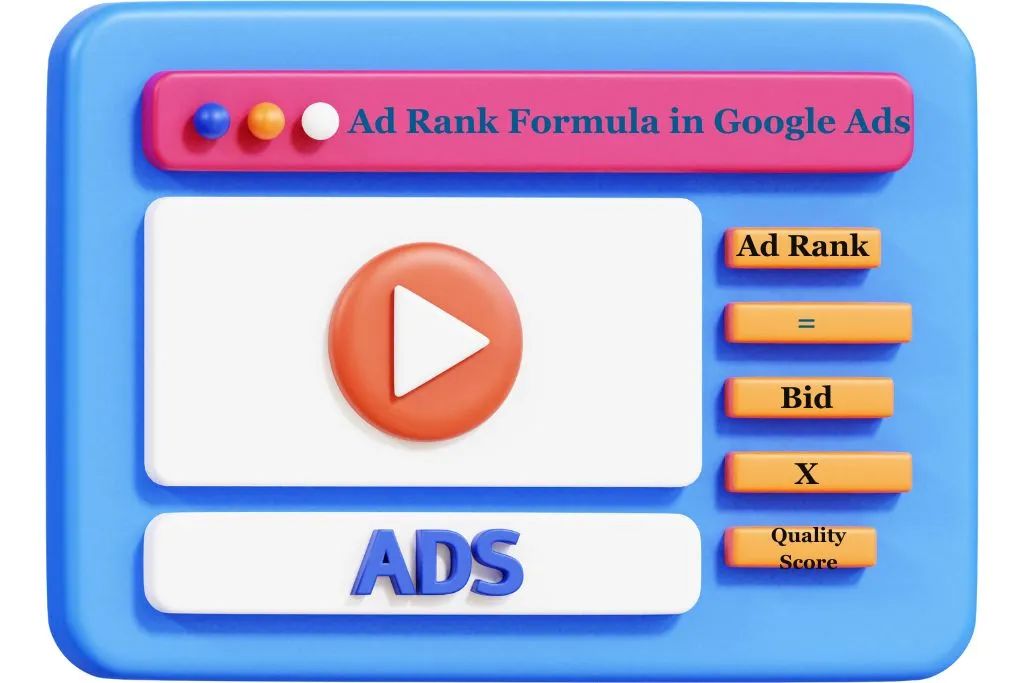Ad Rank Formula in Google Ads: Mastering Google Ads Ad Rank

In the dynamic realm of digital advertising, Google Ads stands as a formidable platform, offering businesses unparalleled opportunities to showcase their products or services to a global audience. However, thriving in this competitive landscape necessitates a nuanced understanding of the Ad Rank formula – the algorithm dictating the placement and visibility of ads in Google’s search engine results pages (SERPs). In this comprehensive guide, we’ll delve into the intricacies of the Ad Rank formula and explore actionable strategies to optimize your ads for maximum impact.
Understanding the Ad Rank Formula:
At its core, the Ad Rank formula serves as Google’s mechanism for determining the position and prominence of ads in search engine results pages (SERPs). The formula itself is relatively straightforward:
Ad Rank = Bid x Quality Score
- Bid: Your bid represents the maximum amount you’re willing to pay for a click on your ad. While bid amounts significantly influence ad position, they’re not the sole determinants. Google also factors in ad quality and landing page experience.
- Quality Score: Quality Score, a metric assigned by Google, hinges on the relevance and quality of your ad, keywords, and landing page. It considers factors like click-through rate (CTR), ad relevance, and landing page experience. A higher Quality Score signifies that your ad is more likely to resonate with users, leading to better ad placement at a lower cost.
Strategies to Enhance Ad Performance:
Now that we’ve dissected the Ad Rank formula, let’s explore actionable strategies to optimize your ads:
1. Keyword Research and Selection:
- Conduct thorough keyword research to uncover terms aligning with your target audience’s search intent.
- Prioritize long-tail keywords with lower competition and heightened relevance to attract qualified leads.
2. Craft Compelling Ad Copy:
- Develop concise, compelling ad copy highlighting unique selling points and prompting user action.
- Seamlessly integrate relevant keywords into your ad text to bolster relevance and amplify click-through rates.
3. Optimize Landing Pages:
- Ensure your landing pages are finely tuned for relevance and user experience.
- Furnish clear, pertinent information aligning with the ad’s messaging and streamline the conversion process to minimize friction.
4. Augment Ad Relevance:
- Align your ad messaging with users’ search queries to amplify relevance and engagement potential.
- Create ad groups housing tightly themed keywords to fortify ad relevance and Quality Score.
5. Boost Click-Through Rate (CTR):
- Experiment with diverse ad formats, headlines, and call-to-action (CTA) phrases to entice users to click.
- Continuously monitor and optimize ad performance to identify and rectify underperforming ads.
6. Leverage Ad Extensions:
- Harness ad extensions such as sitelinks, callouts, and structured snippets to furnish additional information and amplify ad visibility.
- Strategically deploy ad extensions to spotlight key selling points and stimulate clicks.
7. Monitor and Adjust Bids:
- Regularly scrutinize your bid strategy and fine-tune bids based on performance metrics and campaign objectives.
- Employ bid modifiers to tailor bids for specific demographics, devices, locations, or times of day to maximize returns.
8. Test and Iterate:
- Employ A/B testing to juxtapose different ad variations and discern resonating elements with your audience.
- Continuously iterate and refine your ads predicated on performance data and user feedback to drive perpetual enhancements.
Deciphering Competitive Ad Rank and Monitoring:
To thrive in the fiercely competitive landscape, vigilantly monitor your ad rank and recalibrate strategies accordingly. Keep a vigilant eye on competitive ad rank and factors underpinning it to make informed decisions about bidding and optimization endeavors.
Final Thoughts:
In the fiercely competitive landscape of Google Ads, mastering the Ad Rank formula is paramount for unlocking optimal ad performance. By meticulously honing bid management, Quality Score optimization, and ad relevance, advertisers can ascend the ranks, attract qualified leads, and maximize returns on investment. By implementing the strategies delineated in this guide and perpetually fine-tuning ad performance, businesses can harness the full potential of Google Ads as a potent marketing tool.
Do you Want
More App Downloads?
Boost the Mobile App Growth with the Ultimate Mobile App Marketing Experts
Latest Blogs
Do you Want
More App Downloads?
Boost the Mobile App Growth with the Ultimate Mobile App Marketing Experts
Ad Rank is a metric used by Google to determine the position of ads in search engine results pages (SERPs). It’s calculated based on a combination of bid amount and ad quality factors like relevance and landing page experience.
To improve your Ad Rank, focus on optimizing your bid strategy, enhancing ad quality through compelling ad copy and relevant keywords, and ensuring a seamless landing page experience.
Ad Rank is influenced by bid amount, ad quality (Quality Score), expected click-through rate (CTR), ad relevance, landing page experience, and ad extensions.
Ad Rank directly impacts ad position in search results. Higher Ad Rank can lead to better visibility, more clicks, and potentially lower costs per click (CPC).
es, you can monitor your Ad Rank in Google Ads by accessing the “Ad Preview and Diagnosis” tool, reviewing performance reports, and using third-party tools for more detailed insights.




